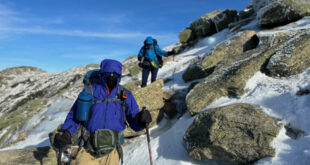While ultralight tents are easier to carry because they weigh less, you usually have to sacrifice something in terms of comfort, ease of use, or weather protection to use one. The weight reduction doesn’t come for free, even if the tent is …
Read More »Frequently Asked Questions
Liquid Fuel – White Gas Stove Guide
If you plan on winter camping or backpacking in temperatures below 15 degrees Fahrenheit, you should consider getting a liquid fuel stove that burns petroleum distillates like white gas or kerosene instead of a canister-based stove that burns isobutane fuel. Canister gas …
Read More »What is the Difference Between a Rain Jacket and a Hard Shell?
Hard shell jackets are a burly type of rain jacket, usually made with waterproof/breathable fabric, that is used for cold weather hiking as a windproof and waterproof clothing layer. They have a richer set of temperature regulation features and pockets than warm …
Read More »Choosing the Right DEET Concentration for Effective Protection
DEET is still the most widely used insect repellent in use today. It is available in multiple concentrations ranging from 10 percent up to 100 percent. The main difference between the different concentrations is how long they remain effective. For example, a …
Read More »What is the Fill Power of Synthetic Insulation?
How does synthetic insulation compare to down insulation in terms of warmth? You might be surprised how lackluster it is in comparison, even with recent advances in the types of synthetic insulation available. Fill power is used to measure the warmth of …
Read More »How Many Days of Food Can You Pack in a Bear Canister or Ursack?
There’s a simple rule of thumb for figuring out how many days of food you can fit into a bear canister. Find out the capacity of your bear canister in cubic inches and divide by 100. That will give you a pretty …
Read More »How to Carry a Bear Canister: Tips and Tricks
Bear canisters are pretty awkward to carry with a backpack. Do you put it inside your pack, outside, on top, or underneath? Are some backpacks better for carrying a canister than others? What’s the best way to carry a canister with a …
Read More »How Effective are DWR Restoration Treatments?
Waterproof breathable rain jackets are not permanently breathable. Instead, they’re coated with a chemical formulation called DWR, which stands for Durable Water Repellancy, that causes water to bead up on the jacket surface when it rains and roll off. The problem is …
Read More »How to Stop Your Superfeet Insoles from Squeaking
The second most annoying sound in this world is the sound of insoles squeaking when you walk. If you’re a hiker or backpacker, listening to this sound while you hike, mile after mile, will drive you mad…not to mention your partners. But …
Read More »Sleeping Pad R-Values and Temperature Ratings: How They Correspond
Backpacking and camping sleeping pads are rated using R-values which measure their ability to keep you warm when you lie down on the cold ground. The higher the R-value, the greater the insulating power. It’s much more technical than that, but that’s …
Read More »Do You Need a Pack Liner for a Waterproof Backpack?
More and more ultralight backpacking packs are being made with waterproof materials like Dyneema Composite Fabrics (DCF), Ultra, Liteskin, EcoPak, and XPac. These fabrics absorb very little water and are bonded with a waterproof layer that prevents them from being soaked through …
Read More »What is Skin Out Weight in Backpacking?
Skin Out Weight is the weight of your backpacking gear, water, food, fuel, the clothing you’re wearing, your shoes, watch, sunglasses, smartphone, trekking poles if you use them, and anything else on your person or in your pack. Backpacking Base Weight, in …
Read More »Maximizing Storage: Tips for Packing a 60 Liter Backpack
A 60-liter backpack is the sweet spot for backpacking trips 5 days in length or less, including packs in the 55-liter to 65-liter range. This backpack volume is large enough to hold a sleeping bag, a one or two-person tent (or a …
Read More »How Do Thru-Hikers Navigate on the AT and PCT?
When preparing to thru-hike the Appalachian Trail or Pacific Crest Trails (AT & PCT), people tend to wonder just how much navigation skill is actually needed to stay on the right path and not get lost. I’m often asked how I found …
Read More » SectionHiker.com Backpacking Gear Reviews and FAQs
SectionHiker.com Backpacking Gear Reviews and FAQs 












